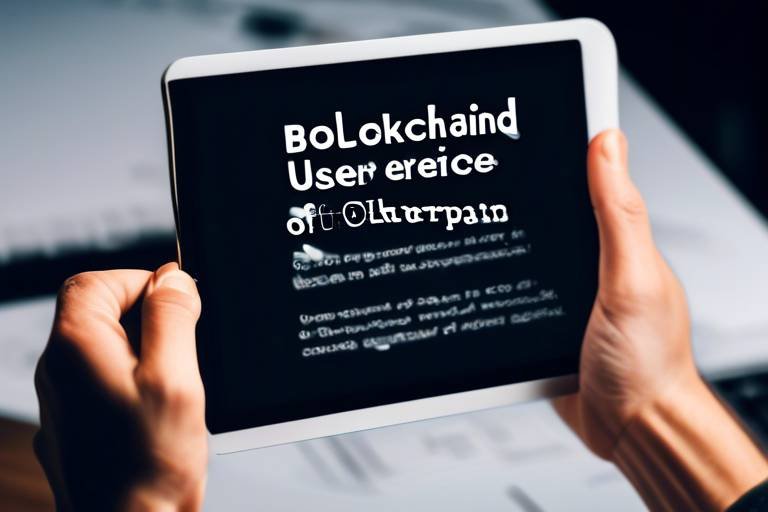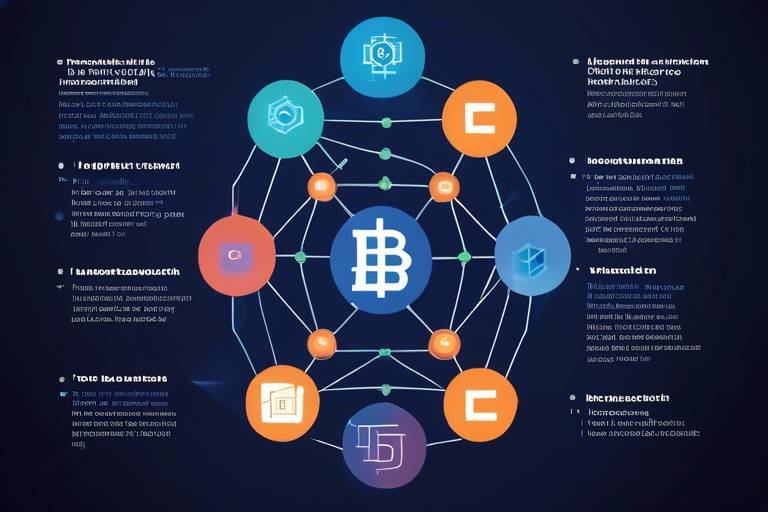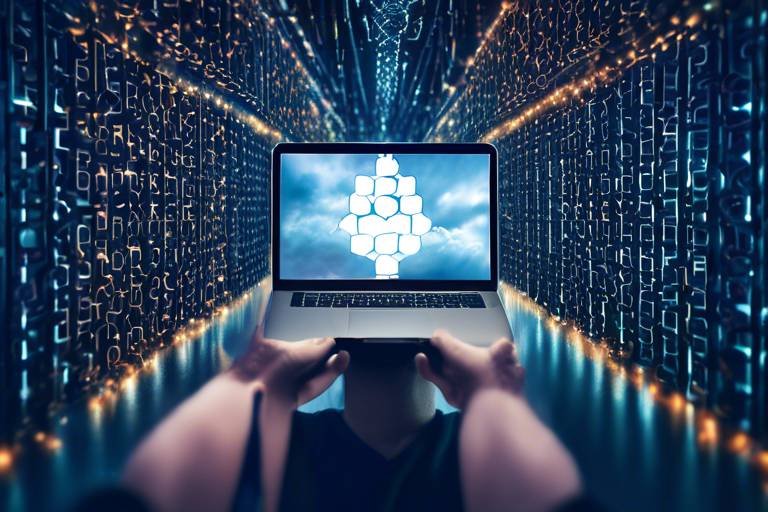Understanding the Potential of Blockchain for Social Good
In today's rapidly evolving technological landscape, blockchain stands out as a revolutionary force that holds immense potential for driving social change. But what exactly is blockchain? At its core, blockchain is a decentralized ledger technology that enables secure and transparent record-keeping of transactions across a network of computers. This means that instead of relying on a single central authority, like a bank or government, blockchain distributes control among all participants, enhancing security and trust.
Imagine a world where every charitable donation is tracked and verified, ensuring that funds reach their intended recipients without corruption or mismanagement. Picture a scenario where individuals in underserved communities can access financial services typically reserved for the privileged few. These are just a couple of the possibilities that blockchain technology can unlock for social good. By promoting transparency and equity, blockchain can address some of the most pressing social challenges of our time.
Throughout this article, we will explore various applications of blockchain technology that are not only innovative but also transformative. From enhancing accountability in supply chains to empowering marginalized populations with access to financial services, the potential applications are vast and varied. Additionally, we will highlight real-world case studies that demonstrate how organizations are harnessing this technology to create a positive impact in their communities.
As we delve deeper, we will also consider the challenges and limitations that accompany the adoption of blockchain for social good. While the technology is promising, it is not without its hurdles. Issues such as scalability, regulatory frameworks, and the need for public education must be addressed to fully realize its potential.
In conclusion, blockchain technology is more than just a buzzword; it is a powerful tool that can facilitate significant social change. By fostering transparency, empowering underserved communities, and enhancing accountability, blockchain can pave the way for a more equitable and sustainable future. Join us as we explore the myriad ways in which blockchain is making a difference and the exciting prospects that lie ahead.
- What is blockchain technology? - Blockchain is a decentralized digital ledger that records transactions across multiple computers, ensuring security and transparency.
- How can blockchain promote social good? - By enhancing transparency, accountability, and access to resources, blockchain can address various social challenges.
- What are some challenges of implementing blockchain? - Challenges include scalability, regulatory issues, and the need for public awareness and education.

Introduction to Blockchain Technology
Blockchain technology is often hailed as a revolutionary force, but what exactly does it entail? At its core, blockchain is a decentralized digital ledger that records transactions across many computers in such a way that the registered transactions cannot be altered retroactively. This technology operates on a peer-to-peer network, which means that instead of relying on a central authority, every participant in the network has access to the entire ledger. Imagine a group of friends who all keep their own copies of a shared diary; if one person tries to change an entry, everyone else will know it’s been tampered with. This is the essence of how blockchain ensures transparency and security.
The structure of a blockchain consists of a series of blocks, each containing a list of transactions. Each block is linked to the previous one, forming a chain. This linkage is secured through cryptographic hashes, which serve as unique fingerprints for each block. If someone tries to alter a block, the hash changes, and the entire chain becomes invalid. This makes blockchain incredibly resistant to fraud and manipulation.
To better understand how blockchain operates, here are some fundamental principles:
- Decentralization: No single entity controls the entire chain, reducing the risk of corruption.
- Transparency: All transactions are visible to participants, fostering trust.
- Immutability: Once recorded, transactions cannot be changed, ensuring data integrity.
- Security: Advanced cryptographic techniques protect data from unauthorized access.
Blockchain technology has the potential to transform various industries by providing a reliable framework for transactions. It’s not just about cryptocurrencies like Bitcoin; its applications span from supply chain management to healthcare, and even voting systems. By leveraging blockchain, organizations can enhance their operational efficiency, reduce costs, and improve accountability. As we delve deeper into this article, we will explore how this innovative technology can address social challenges and promote equitable access to resources.

Transparency and Accountability
In today's world, where trust is often in short supply, transparency and accountability have become paramount in various sectors. Blockchain technology, with its unique decentralized structure, offers a groundbreaking solution to these challenges. Imagine a world where every transaction is recorded in an immutable ledger, visible to all, yet secure from tampering. This is the essence of blockchain—a system that not only enhances visibility but also ensures that all parties involved are held accountable for their actions.
One of the most compelling aspects of blockchain is its ability to foster transparency across different industries. For instance, in supply chain management, blockchain can track the journey of a product from its origin to the consumer's hands. This level of detail allows consumers to verify the authenticity of products and ensures that businesses operate ethically. In fact, a recent study revealed that over 70% of consumers are willing to pay more for products from brands that are transparent about their sourcing and production processes. This shift in consumer behavior highlights the growing demand for accountability.
Moreover, blockchain's potential in the realm of charity and donations cannot be overstated. Traditional charity models often suffer from a lack of transparency, leading to skepticism about how funds are used. With blockchain, every donation can be tracked, showing exactly how and where the money is spent. This not only builds trust with donors but also encourages more people to contribute to causes they care about. A notable example is BitGive, a nonprofit organization that uses blockchain to provide transparency in charitable donations, ensuring that funds reach their intended recipients without unnecessary overhead costs.
Furthermore, the use of blockchain in government operations is another area ripe for transformation. By implementing blockchain for public records, governments can enhance accountability and reduce corruption. Citizens could access public data in real-time, allowing them to hold officials accountable for their decisions. Imagine being able to see how tax dollars are spent or how public projects are managed, all through a secure and transparent system. This could lead to a significant reduction in fraud and mismanagement of resources.
However, while the benefits of blockchain for transparency and accountability are clear, it's essential to recognize that the technology is not a panacea. There are still challenges to overcome, such as the need for widespread adoption and the integration of blockchain with existing systems. Additionally, the complexity of the technology can create barriers to understanding for the average user. Education and awareness are crucial in ensuring that the potential of blockchain is fully realized.
In conclusion, blockchain technology stands as a beacon of hope for enhancing transparency and accountability across various sectors. By leveraging its capabilities, we can create a more trustworthy environment where individuals and organizations are held responsible for their actions. As we continue to explore and implement blockchain solutions, the promise of a more transparent future is within our grasp.

Empowering Underserved Communities
In today's fast-paced world, many communities find themselves on the fringes of economic growth, lacking access to essential services and opportunities. Blockchain technology has emerged as a powerful tool that can bridge this gap, offering innovative solutions to empower these underserved populations. Imagine a world where individuals in remote areas can access banking services with just a smartphone. With blockchain, this vision is becoming a reality. By providing decentralized financial services, blockchain removes the barriers that traditional banking systems impose, such as high fees and complicated processes.
One of the most significant advantages of blockchain is its ability to facilitate microfinancing. This is particularly important for small entrepreneurs in developing regions who often struggle to secure loans from conventional banks. Through blockchain platforms, these individuals can connect with investors directly, bypassing traditional financial institutions. This not only democratizes access to funds but also encourages local economic growth. For instance, a farmer in a rural area can receive a small loan to buy seeds, which can then lead to increased crop yields and a better quality of life for their family and community.
Moreover, blockchain enhances transparency in financial transactions. When funds are transferred using blockchain technology, every transaction is recorded on a public ledger that is immutable and accessible to all. This means that donors can track their contributions to charitable organizations, ensuring that their money is used effectively. For example, a nonprofit organization aiming to provide educational resources can use blockchain to show exactly how donations are spent, building trust with their supporters and encouraging further contributions.
In addition to financial services, blockchain can also facilitate access to essential resources like healthcare and education. By creating decentralized platforms, individuals can share their skills and knowledge, allowing for a more equitable distribution of resources. For instance, a teacher in an urban area could offer online classes to students in remote villages, breaking down geographical barriers and providing quality education to those who need it most.
As we look to the future, it's crucial to recognize the potential of blockchain to empower underserved communities. However, it’s also important to address the challenges that come with this technology. Issues such as digital literacy and access to technology must be tackled to ensure that everyone can benefit from these advancements. Initiatives aimed at educating communities about blockchain and its applications are vital in creating an inclusive digital economy.
In summary, blockchain technology holds immense potential to empower underserved communities by providing access to financial services, enhancing transparency, and facilitating educational opportunities. As we continue to explore and develop these technologies, we must remain committed to ensuring that no one is left behind in this digital revolution.
- What is blockchain technology?
Blockchain is a decentralized digital ledger that securely records transactions across multiple computers. It ensures that the recorded information cannot be altered retroactively, providing transparency and security. - How does blockchain empower underserved communities?
By providing access to decentralized financial services, enhancing transparency in transactions, and enabling educational opportunities, blockchain technology can help bridge the gap for underserved populations. - What are the challenges of implementing blockchain for social good?
Key challenges include digital literacy, access to technology, regulatory issues, and the need for public awareness and education on blockchain applications. - Can blockchain help in microfinancing?
Yes, blockchain can connect small entrepreneurs directly with investors, allowing them to secure loans without the barriers imposed by traditional banking systems.

Blockchain in Humanitarian Aid
In recent years, the world has witnessed a surge in humanitarian crises, from natural disasters to armed conflicts. These situations often lead to a chaotic environment where delivering aid efficiently becomes a daunting task. Enter blockchain technology, a game-changer that promises to revolutionize the way humanitarian aid is distributed and managed. By leveraging the decentralized nature of blockchain, organizations can ensure that aid reaches those who need it most, without the typical bottlenecks and inefficiencies associated with traditional systems.
One of the most significant advantages of blockchain in humanitarian aid is its ability to enhance the traceability of funds. In many cases, funds allocated for relief efforts can get lost in bureaucratic red tape, leading to delays that can mean the difference between life and death for those in need. With blockchain, every transaction is recorded on a public ledger, making it possible to track the flow of money from donor to recipient. This transparency not only builds trust among donors but also ensures that resources are used effectively. For example, a charity can provide real-time updates on how donations are being spent, allowing donors to see the direct impact of their contributions.
Moreover, blockchain can streamline the entire aid distribution process. Traditional methods often rely on intermediaries, which can slow down the delivery of resources. By utilizing smart contracts—self-executing contracts with the terms of the agreement directly written into code—organizations can automate various processes. For instance, when certain conditions are met, such as the arrival of aid supplies in a disaster-stricken area, the smart contract can automatically release funds to local partners, ensuring a swift response.
Another area where blockchain shines is in the management of identity verification. In many humanitarian crises, individuals may lack proper identification, making it challenging to distribute aid equitably. Blockchain can facilitate the creation of a secure digital identity for individuals, allowing them to access services and aid without the need for traditional identification methods. This not only empowers individuals but also helps organizations verify the authenticity of claims, reducing the risk of fraud.
To illustrate the impact of blockchain in humanitarian aid, consider the case of the World Food Programme (WFP). They have implemented a blockchain-based system called Building Blocks, which allows refugees to receive food assistance using biometric data. This system ensures that aid reaches the intended recipients while minimizing the risk of fraud and misuse. In a pilot project in Jordan, WFP was able to provide food assistance to over 10,000 refugees, showcasing the potential of blockchain to transform humanitarian efforts.
However, while the benefits are evident, there are also challenges to implementing blockchain in humanitarian aid. Issues such as scalability, regulatory hurdles, and the need for public awareness and education remain significant obstacles. Organizations must navigate these challenges to fully harness the potential of blockchain technology.
In conclusion, blockchain technology is poised to make a significant impact in the realm of humanitarian aid. By enhancing transparency, streamlining processes, and providing secure identity solutions, it can transform the way aid is delivered and managed. As more organizations begin to explore and adopt blockchain solutions, we can expect to see a more efficient and effective humanitarian response to crises around the globe.
- What is blockchain technology? Blockchain is a decentralized digital ledger that records transactions across many computers securely and transparently.
- How does blockchain improve transparency in humanitarian aid? It allows for real-time tracking of funds and resources, ensuring that aid reaches the intended recipients.
- What are smart contracts? Smart contracts are self-executing contracts with the terms directly written into code, allowing for automated processes in aid distribution.
- Can blockchain help with identity verification in humanitarian crises? Yes, it can create secure digital identities, enabling individuals to access services and aid without traditional identification.

Decentralized Identity Solutions
In an increasingly digital world, the concept of identity has evolved beyond mere names and ID numbers. With the rise of , individuals can now take control of their own identities, ensuring privacy and security like never before. Imagine a world where you can prove who you are without having to share all your personal information. Sounds revolutionary, right? Well, that's exactly what blockchain technology offers!
Decentralized identity solutions leverage blockchain's inherent features to create a secure and portable digital identity for individuals. This means that rather than relying on centralized authorities—like governments or corporations—to validate your identity, you can use cryptographic methods to verify your credentials. This not only enhances privacy but also reduces the risk of identity theft, which is a growing concern in our online lives.
One of the key benefits of decentralized identity solutions is their ability to empower individuals, especially those in underserved communities. For instance, many people around the world lack formal identification, which can hinder their access to essential services such as banking, healthcare, and education. By utilizing blockchain technology, these individuals can create a verified identity that is recognized globally without the need for traditional documentation. This opens up a world of opportunities, allowing them to participate fully in society.
Moreover, decentralized identities can be tailored to meet specific needs. For example, a user could choose to share only certain pieces of information with different entities. When applying for a job, they might share their educational qualifications but keep their home address private. This selective sharing not only protects personal data but also fosters trust between individuals and organizations. It’s like having a digital wallet where you can choose what to show and what to keep hidden.
Let’s take a look at some real-world applications of decentralized identity solutions:
| Application | Description |
|---|---|
| Healthcare | Patients can control who accesses their medical records, ensuring privacy and security. |
| Banking | Individuals can create a verified identity to access banking services without traditional documentation. |
| Voting | Decentralized identities can ensure secure and anonymous voting processes in elections. |
Despite its numerous advantages, the implementation of decentralized identity solutions is not without challenges. Issues such as regulatory compliance, technological infrastructure, and public awareness must be addressed to ensure widespread adoption. However, as more organizations begin to recognize the potential of blockchain for identity management, we can expect to see significant advancements in this area.
In conclusion, decentralized identity solutions represent a transformative shift in how we view and manage personal identity in the digital age. By putting individuals in control of their own identities, we can foster greater trust, security, and accessibility in a world that increasingly relies on digital interactions. The future is bright for decentralized identities, and as we continue to explore this innovative technology, the possibilities are truly endless!
- What is a decentralized identity? A decentralized identity is a digital identity that is managed by the individual rather than a central authority, using blockchain technology for verification.
- How does decentralized identity enhance privacy? It allows individuals to share only necessary information with different entities while keeping other personal details private.
- Can decentralized identities be used in healthcare? Yes, they can be used to control access to medical records, ensuring that only authorized individuals can view sensitive information.
- What are the challenges of implementing decentralized identities? Challenges include regulatory compliance, technological infrastructure, and the need for public awareness and education.

Environmental Sustainability
When we think about the future of our planet, the term often comes to the forefront of discussions. With climate change, pollution, and resource depletion looming over us, finding innovative solutions is more crucial than ever. Enter blockchain technology—a game-changer that can help us tackle these pressing issues head-on. But how does blockchain fit into the picture? Let's dive in!
At its core, blockchain offers a decentralized and transparent way to track and verify transactions. This unique feature can be harnessed to enhance sustainability efforts across various sectors. For instance, it allows companies to track their carbon emissions in real-time, providing a clear view of their environmental impact. Imagine a world where every business is held accountable for its carbon footprint, and consumers can make informed choices based on verified data. Wouldn't that be a remarkable shift toward a more sustainable future?
Moreover, blockchain can facilitate the promotion of renewable energy. Through decentralized energy grids, individuals can trade excess energy generated from solar panels or wind turbines with their neighbors. This not only empowers communities but also encourages the adoption of clean energy sources. By using blockchain to manage these transactions, we can ensure that energy trading is secure, transparent, and efficient. It's like having a local farmer's market for energy, where everyone benefits!
In addition to energy, blockchain can support sustainable supply chains. By providing a transparent ledger, companies can trace the origin of their products, ensuring that they are sourced responsibly. This is particularly important in industries like fashion and food, where ethical sourcing and sustainability are increasingly demanded by consumers. With blockchain, we can verify that products are made without exploiting labor or harming the environment, creating a more ethical marketplace.
To illustrate the impact of blockchain on environmental sustainability, consider the following table:
| Application | Description | Benefits |
|---|---|---|
| Carbon Tracking | Real-time monitoring of carbon emissions | Increased accountability and reduction in emissions |
| Renewable Energy Trading | Decentralized platforms for energy exchange | Empowers communities and promotes clean energy |
| Sustainable Supply Chains | Traceability of product sourcing | Ensures ethical practices and consumer trust |
As we explore the potential of blockchain for environmental sustainability, it’s essential to recognize its role in fostering a circular economy. This concept revolves around minimizing waste and making the most of resources. Blockchain can help track the lifecycle of products, ensuring that materials are reused and recycled effectively. Picture a world where your old phone is not just discarded but instead transformed into a new device, all thanks to the transparent tracking capabilities of blockchain. How cool is that?
However, while blockchain holds immense promise, it’s not without challenges. The energy consumption of some blockchain networks has raised concerns about their environmental impact. This paradox highlights the need for ongoing innovation and the development of more energy-efficient blockchain solutions. As we move forward, it’s crucial to strike a balance between leveraging blockchain's capabilities and ensuring that its implementation aligns with our sustainability goals.
In conclusion, blockchain technology presents a unique opportunity to drive environmental sustainability. By enhancing transparency, accountability, and efficiency, it can empower individuals and organizations alike to make more responsible choices. As we continue to explore the potential of this technology, we must remain committed to using it as a tool for positive change. After all, the future of our planet depends on the actions we take today.
- How does blockchain help in tracking carbon emissions?
Blockchain allows for real-time monitoring of emissions, providing a transparent record that holds companies accountable for their environmental impact. - Can blockchain promote renewable energy?
Yes! Blockchain enables decentralized energy trading, allowing individuals to buy and sell excess energy generated from renewable sources. - What is a circular economy?
A circular economy focuses on minimizing waste and maximizing resource use, and blockchain can help track the lifecycle of products to support this model. - Are there challenges to using blockchain for sustainability?
Yes, challenges include energy consumption of some blockchain networks and the need for ongoing innovation to ensure sustainability goals are met.

Healthcare Innovations
In recent years, the healthcare sector has been undergoing a remarkable transformation, and one of the most exciting catalysts for this change is blockchain technology. Imagine a world where patient data is not only secure but also easily accessible to authorized personnel, allowing for seamless communication between healthcare providers. This is not just a dream; it's a reality that blockchain is making possible. With its decentralized nature, blockchain can ensure that sensitive health information is protected from unauthorized access while providing a transparent and immutable record of patient interactions.
One of the most significant innovations in healthcare facilitated by blockchain is the enhancement of data security. Traditional systems often suffer from vulnerabilities that can lead to data breaches, compromising patient privacy. Blockchain addresses these concerns by encrypting data and distributing it across a network of nodes. This means that even if one node is compromised, the integrity of the entire system remains intact. As a result, patients can have greater confidence that their personal information is safe.
Moreover, blockchain can revolutionize the way health information is exchanged between providers. Currently, interoperability remains a major challenge in healthcare, with different systems often unable to communicate effectively. Blockchain can facilitate a standardized approach to sharing health records, enabling healthcare professionals to access comprehensive patient histories in real-time. This capability not only improves the quality of care but also reduces the likelihood of medical errors, which can have devastating consequences.
Another area where blockchain shines is in clinical trials. The process of conducting clinical trials is often plagued by issues such as data tampering and lack of transparency. By utilizing blockchain, researchers can create a secure and transparent ledger of all trial data, ensuring that findings are credible and verifiable. This enhances trust among stakeholders, including patients, healthcare providers, and regulatory bodies. Furthermore, it can accelerate the drug development process, ultimately leading to faster access to new therapies for patients in need.
In addition to these innovations, blockchain can also play a crucial role in tracking pharmaceuticals. The opioid crisis has highlighted the need for better tracking of medications to prevent misuse and ensure that patients receive the correct prescriptions. Blockchain can provide a tamper-proof record of the supply chain, from manufacturer to pharmacy, ensuring that medications are legitimate and safe. This level of transparency is essential for combating fraud and protecting public health.
As we explore these innovations, it's essential to recognize that the integration of blockchain in healthcare is still in its infancy. Many organizations are conducting pilot programs to test its feasibility and effectiveness. However, the potential benefits are too significant to ignore. By fostering collaboration among healthcare providers, technology companies, and regulatory agencies, we can pave the way for a more efficient and secure healthcare system.
In conclusion, the innovations brought forth by blockchain technology in healthcare are not just theoretical; they are practical solutions that can address some of the most pressing challenges in the industry. As we continue to embrace this technology, we can look forward to a future where patient care is more secure, efficient, and accessible than ever before.
- What is blockchain technology? Blockchain is a decentralized digital ledger that securely records transactions across multiple computers, ensuring that the data is transparent and tamper-proof.
- How does blockchain improve healthcare data security? Blockchain encrypts patient data and distributes it across a network, making it difficult for unauthorized users to access sensitive information.
- Can blockchain help with clinical trials? Yes, blockchain can enhance transparency and credibility in clinical trials by providing a secure and immutable record of all trial data.
- What are the challenges of implementing blockchain in healthcare? Some challenges include regulatory hurdles, the need for public awareness, and the integration of blockchain with existing healthcare systems.

Challenges and Limitations
While the potential of blockchain technology for social good is undeniably exciting, it is crucial to acknowledge the that come with its implementation. One of the most significant hurdles is scalability. As more users join a blockchain network, the volume of transactions increases, which can lead to slower processing times and higher transaction fees. This is particularly concerning for initiatives aimed at underserved populations, where affordability and speed are critical.
Another challenge is the regulatory landscape. Blockchain operates in a decentralized manner, which can create friction with existing laws and regulations. Different countries have varying approaches to blockchain technology, and this inconsistency can hinder the ability to implement solutions on a global scale. For instance, some governments may impose strict regulations that stifle innovation, while others may lack the necessary frameworks to support blockchain initiatives.
Additionally, there is a pressing need for public awareness and education. Many people still have a limited understanding of what blockchain is and how it can be utilized for social good. This lack of knowledge can lead to skepticism and resistance, making it difficult to gain widespread support for blockchain projects. To address this, stakeholders must invest in educational campaigns that demystify blockchain technology and highlight its potential benefits.
Moreover, the issue of interoperability cannot be overlooked. Different blockchain platforms often operate in silos, which can create barriers to collaboration and data sharing. For example, if a humanitarian organization uses one blockchain platform to track donations while another uses a different system for tracking aid distribution, the two systems may not communicate effectively. This lack of interoperability can limit the overall impact of blockchain solutions.
Lastly, there are security concerns that need to be addressed. Although blockchain is generally considered secure due to its decentralized nature, vulnerabilities can still exist. For instance, smart contracts—self-executing contracts with the terms of the agreement directly written into code—can be exploited if not properly coded. This raises questions about the reliability of blockchain solutions in sensitive areas such as healthcare or financial services.
In summary, while blockchain holds immense promise for addressing social challenges, it is essential to navigate the associated challenges carefully. By recognizing the limitations and actively working to overcome them, we can harness the full potential of blockchain technology to drive social change.
- What are the main challenges of implementing blockchain for social good?
Some key challenges include scalability, regulatory issues, public awareness, interoperability, and security concerns. - How does scalability affect blockchain projects?
As the number of users and transactions increases, scalability can lead to slower processing times and higher fees, which may limit accessibility. - Why is public awareness important for blockchain initiatives?
A lack of understanding can lead to skepticism and resistance, making it harder to gain support for blockchain projects. - What is interoperability in blockchain?
Interoperability refers to the ability of different blockchain platforms to communicate and share data, which is crucial for maximizing the impact of blockchain solutions.

Future Prospects of Blockchain for Social Good
The future of blockchain technology in the realm of social good is not just promising; it’s downright exciting! As we look ahead, the potential for blockchain to transform various sectors continues to expand, with innovative applications emerging almost daily. Imagine a world where transparency, accountability, and accessibility are not just ideals but realities, thanks to the power of decentralized technology. This isn’t just a pipe dream; it’s a tangible future that is already taking shape.
One of the most intriguing prospects is the emergence of collaborative platforms that leverage blockchain to unite various stakeholders, from governments to non-profits and businesses. These platforms can facilitate partnerships that drive social impact initiatives, fostering a sense of community and shared responsibility. For instance, consider a blockchain-based platform that connects local farmers directly with consumers, ensuring fair prices and reducing food waste. This not only empowers farmers but also promotes sustainable practices, creating a win-win scenario for everyone involved.
Moreover, the integration of blockchain with other cutting-edge technologies, such as artificial intelligence (AI) and the Internet of Things (IoT), could unlock even greater potential. For example, AI can analyze data on blockchain to identify trends and insights that can inform decision-making in social programs. Meanwhile, IoT devices can provide real-time data that enhances the effectiveness of humanitarian aid efforts. Together, these technologies can create a more responsive and efficient system that addresses social challenges head-on.
Another exciting area is the development of decentralized finance (DeFi) solutions aimed at underserved communities. Imagine individuals in remote areas gaining access to banking services through blockchain-based apps, allowing them to save, borrow, and invest without the need for traditional banking infrastructure. This could revolutionize financial inclusion, providing opportunities for economic growth and empowerment in places where such access has been historically limited.
As we embrace these advancements, it's essential to consider the role of education and awareness in maximizing blockchain's impact for social good. A well-informed public can drive demand for blockchain solutions, pushing governments and organizations to adopt and implement these technologies. Initiatives that promote understanding of blockchain's benefits and functionalities will be crucial in fostering a culture of innovation and collaboration.
However, while the prospects are bright, we must also remain vigilant about the challenges that lie ahead. Issues such as regulatory hurdles, scalability concerns, and the need for robust infrastructure must be addressed to fully realize blockchain's potential. Collaboration between tech developers, policymakers, and community leaders will be vital in overcoming these obstacles and ensuring that blockchain serves as a tool for positive change.
In conclusion, the future of blockchain for social good is filled with opportunities waiting to be seized. As we continue to innovate and explore new applications, the impact of this technology could be transformative, paving the way for a more equitable and sustainable world. The journey has just begun, and we are all invited to be part of this exciting adventure!
- What is blockchain technology? Blockchain is a decentralized digital ledger that records transactions across many computers securely and transparently.
- How can blockchain help in social good initiatives? It enhances transparency, accountability, and accessibility in various sectors, empowering underserved communities and streamlining processes.
- What are some real-world applications of blockchain for social good? Examples include decentralized finance solutions, supply chain transparency, and secure digital identities.
- What challenges does blockchain face in the social sector? Key challenges include regulatory issues, scalability, and the need for public education on blockchain technology.
Frequently Asked Questions
- What is blockchain technology?
Blockchain technology is a decentralized and secure system for recording transactions and data. It operates as a distributed ledger where information is stored across multiple computers, ensuring that no single entity has control over the entire network. This enhances security and transparency, making it ideal for various applications.
- How does blockchain promote transparency?
Blockchain fosters transparency by allowing all participants in a network to access the same information. This means that processes like supply chain management and charity donations can be tracked in real-time, ensuring accountability and reducing the risk of fraud.
- Can blockchain help underserved communities?
Absolutely! Blockchain can provide financial services to underserved populations, giving them access to banking, loans, and economic opportunities that were previously out of reach. This empowers individuals and helps lift communities out of poverty.
- What role does blockchain play in humanitarian aid?
In humanitarian efforts, blockchain streamlines aid distribution, ensures the traceability of funds, and enhances the efficiency of relief operations. This means that help gets to those in need faster and more effectively, minimizing waste and maximizing impact.
- What are decentralized identity solutions?
Decentralized identity solutions use blockchain to create secure and portable digital identities. This empowers individuals by giving them control over their personal information, while also protecting their privacy in various social and economic contexts.
- How can blockchain contribute to environmental sustainability?
Blockchain can track carbon emissions, promote renewable energy, and support sustainable supply chains. By providing transparent data, it encourages responsible practices and helps organizations meet their sustainability goals.
- What innovations does blockchain bring to healthcare?
In healthcare, blockchain enhances data security and patient privacy, allowing for improved health information exchange. This ensures that sensitive medical data is protected while facilitating better coordination of care among providers.
- What challenges does blockchain face in social good applications?
Some challenges include scalability issues, regulatory hurdles, and the need for greater public awareness and education about blockchain technology. Overcoming these obstacles is crucial for maximizing its potential in social good initiatives.
- What does the future hold for blockchain in the social sector?
The future of blockchain in the social sector looks promising, with emerging trends, potential partnerships, and an evolving landscape of social impact initiatives. As technology advances, we can expect to see even more innovative applications that address pressing social challenges.



















